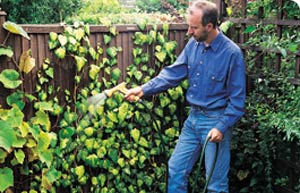
Ivy makes an excellent wall or fence covering. As
long as it's kept in its place and is well managed with regular trims, this
robust and versatile evergreen will make a good backdrop for the most flamboyant
of flower displays,
 1 Prepare a bed close to a
fence or wall by digging over the soil to remove weeds and large stones. Dig
deep to break up heavy soil, then fork in well-rotted manure to improve
drainage. This also helps the soil hold more moisture. Rake the surface level.
1 Prepare a bed close to a
fence or wall by digging over the soil to remove weeds and large stones. Dig
deep to break up heavy soil, then fork in well-rotted manure to improve
drainage. This also helps the soil hold more moisture. Rake the surface level.
 2 Although ivy plants are usually bought with their twining
stems tied to a long cane for support, they shouldn't be planted like this.
Instead, carefully untie all the stems and remove the cane completely. Unravel
and separate the individual stems and lay them to one side.
2 Although ivy plants are usually bought with their twining
stems tied to a long cane for support, they shouldn't be planted like this.
Instead, carefully untie all the stems and remove the cane completely. Unravel
and separate the individual stems and lay them to one side.
 3 A single ivy plant will easily cover a 1.8m (6ft) square
fence panel, so plant it exactly in the middle. Dig out a planting hole close to
the bottom edge of the fence that's deep enough to hold the pot. Fork over the
bottom of the hole to break up the soil.
3 A single ivy plant will easily cover a 1.8m (6ft) square
fence panel, so plant it exactly in the middle. Dig out a planting hole close to
the bottom edge of the fence that's deep enough to hold the pot. Fork over the
bottom of the hole to break up the soil.
 4 Remove the plastic pot and position the rootball in the hole.
Aim to keep the surface of the compost level with that of the surrounding soil.
Pour soil in around the rootball. Firm in by hand or use a boot gently to get
rid of air pockets.
4 Remove the plastic pot and position the rootball in the hole.
Aim to keep the surface of the compost level with that of the surrounding soil.
Pour soil in around the rootball. Firm in by hand or use a boot gently to get
rid of air pockets.
 5 To ensure the widest area of the fence is covered with ivy in
the quickest time, spread out the trailing stems along the base of the fence.
Try to divide the shoots equally between the two sides, laying each stem
directly on the soil so it makes contact.
5 To ensure the widest area of the fence is covered with ivy in
the quickest time, spread out the trailing stems along the base of the fence.
Try to divide the shoots equally between the two sides, laying each stem
directly on the soil so it makes contact.
 6 To encourage each stem to root into the soil along its entire
length, make some wire pegs to push down the stems at regular intervals. These
will hold the stems firmly and prevent them blowing about in the wind. Cover
sections of the stem with soil, keeping the leaves clear.
6 To encourage each stem to root into the soil along its entire
length, make some wire pegs to push down the stems at regular intervals. These
will hold the stems firmly and prevent them blowing about in the wind. Cover
sections of the stem with soil, keeping the leaves clear.
 7 Give the main plant a good watering to settle the soil around
the roots, then water the entire length of the fence to wet the soil covering
the stems. Over the coming weeks, repeat this on a regular basis.
7 Give the main plant a good watering to settle the soil around
the roots, then water the entire length of the fence to wet the soil covering
the stems. Over the coming weeks, repeat this on a regular basis.
 8 Sideshoots won't grow immediately, so be patient. Once the
stems have rooted into the soil they'll send up shoots from virtually every leaf
joint. Ivy is a self-clinging climber, but give it a helping hand by tying in
stems with wire clips pushed into gaps in the panels.
8 Sideshoots won't grow immediately, so be patient. Once the
stems have rooted into the soil they'll send up shoots from virtually every leaf
joint. Ivy is a self-clinging climber, but give it a helping hand by tying in
stems with wire clips pushed into gaps in the panels.
 9 Within a couple of years the ivy will reach the top of the
panel. Keep growth in check by trimming any unruly shoots. Wire in new shoots
growing from the base to fill in any gaps. An occasional foliar liquid feed will
ensure growth remains strong and healthy.
9 Within a couple of years the ivy will reach the top of the
panel. Keep growth in check by trimming any unruly shoots. Wire in new shoots
growing from the base to fill in any gaps. An occasional foliar liquid feed will
ensure growth remains strong and healthy.
![]() Gardeners' Corner
Kids'
Garden
Sustainable Garden
Contact Us
Gardeners' Corner
Kids'
Garden
Sustainable Garden
Contact Us![]()



 1 Prepare a bed close to a
fence or wall by digging over the soil to remove weeds and large stones. Dig
deep to break up heavy soil, then fork in well-rotted manure to improve
drainage. This also helps the soil hold more moisture. Rake the surface level.
1 Prepare a bed close to a
fence or wall by digging over the soil to remove weeds and large stones. Dig
deep to break up heavy soil, then fork in well-rotted manure to improve
drainage. This also helps the soil hold more moisture. Rake the surface level. 2 Although ivy plants are usually bought with their twining
stems tied to a long cane for support, they shouldn't be planted like this.
Instead, carefully untie all the stems and remove the cane completely. Unravel
and separate the individual stems and lay them to one side.
2 Although ivy plants are usually bought with their twining
stems tied to a long cane for support, they shouldn't be planted like this.
Instead, carefully untie all the stems and remove the cane completely. Unravel
and separate the individual stems and lay them to one side. 3 A single ivy plant will easily cover a 1.8m (6ft) square
fence panel, so plant it exactly in the middle. Dig out a planting hole close to
the bottom edge of the fence that's deep enough to hold the pot. Fork over the
bottom of the hole to break up the soil.
3 A single ivy plant will easily cover a 1.8m (6ft) square
fence panel, so plant it exactly in the middle. Dig out a planting hole close to
the bottom edge of the fence that's deep enough to hold the pot. Fork over the
bottom of the hole to break up the soil. 4 Remove the plastic pot and position the rootball in the hole.
Aim to keep the surface of the compost level with that of the surrounding soil.
Pour soil in around the rootball. Firm in by hand or use a boot gently to get
rid of air pockets.
4 Remove the plastic pot and position the rootball in the hole.
Aim to keep the surface of the compost level with that of the surrounding soil.
Pour soil in around the rootball. Firm in by hand or use a boot gently to get
rid of air pockets. 5 To ensure the widest area of the fence is covered with ivy in
the quickest time, spread out the trailing stems along the base of the fence.
Try to divide the shoots equally between the two sides, laying each stem
directly on the soil so it makes contact.
5 To ensure the widest area of the fence is covered with ivy in
the quickest time, spread out the trailing stems along the base of the fence.
Try to divide the shoots equally between the two sides, laying each stem
directly on the soil so it makes contact. 6 To encourage each stem to root into the soil along its entire
length, make some wire pegs to push down the stems at regular intervals. These
will hold the stems firmly and prevent them blowing about in the wind. Cover
sections of the stem with soil, keeping the leaves clear.
6 To encourage each stem to root into the soil along its entire
length, make some wire pegs to push down the stems at regular intervals. These
will hold the stems firmly and prevent them blowing about in the wind. Cover
sections of the stem with soil, keeping the leaves clear. 7 Give the main plant a good watering to settle the soil around
the roots, then water the entire length of the fence to wet the soil covering
the stems. Over the coming weeks, repeat this on a regular basis.
7 Give the main plant a good watering to settle the soil around
the roots, then water the entire length of the fence to wet the soil covering
the stems. Over the coming weeks, repeat this on a regular basis. 8 Sideshoots won't grow immediately, so be patient. Once the
stems have rooted into the soil they'll send up shoots from virtually every leaf
joint. Ivy is a self-clinging climber, but give it a helping hand by tying in
stems with wire clips pushed into gaps in the panels.
8 Sideshoots won't grow immediately, so be patient. Once the
stems have rooted into the soil they'll send up shoots from virtually every leaf
joint. Ivy is a self-clinging climber, but give it a helping hand by tying in
stems with wire clips pushed into gaps in the panels. 9 Within a couple of years the ivy will reach the top of the
panel. Keep growth in check by trimming any unruly shoots. Wire in new shoots
growing from the base to fill in any gaps. An occasional foliar liquid feed will
ensure growth remains strong and healthy.
9 Within a couple of years the ivy will reach the top of the
panel. Keep growth in check by trimming any unruly shoots. Wire in new shoots
growing from the base to fill in any gaps. An occasional foliar liquid feed will
ensure growth remains strong and healthy.